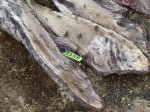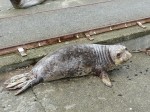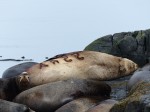Overcast today. Some rain in the afternoon. West winds starting low and increasing during the day and then dropping off again in the evening. Barometric pressure staying just under 1016 hPa all day. A few showers and 15-20 knot winds forecasted for tomorrow. Yesterday there were over a dozen whale watching boats in the reserve. Today only 3 whale watchers. Yesterday there were 4 blasts from DND in the morning around 1000 and 1100h.
Animal Census (for today)
Today the two elephant seal males were sparring ALL day. They started fighting in the water near the jetty at 1100h and continued back and forth into the afternoon (around 1400h). When they eventually returned to land they continued sparring, mainly the larger pursuing the younger one. Even now, they are moving around each other cautiously.
Tried to hook up the VHF radio in the guest house today but had some difficulties with the wiring and the weather. Will try again tomorrow. Some continuing internet issues last night and this morning but hopefully they stay fixed for a while this time.










